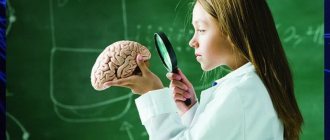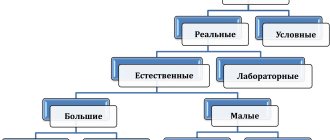See also here: General principles of the structure of the nervous system and its functions
Doing practical work on unconditioned reflexes: Go
Introduction (relevance)
The concept of reflex is very important in physiology. Reflex is the main mode of activity of the nervous system , so it is necessarily part of the basic knowledge about nervous activity. This concept explains the automated work of the body to adapt to influences on it from the external or internal environment.
With the help of reflexes, the nervous system coordinates the activities of the body with signals coming from the surrounding external and internal environment.
Reflex (reflection) is the basic principle and way of working of the nervous system. A more general concept is reactivity . These concepts imply that the reason for the behavioral activity of the organism lies not in the psyche, but outside the psyche , outside the nervous system, and is triggered by signals external to the psyche and the nervous system - stimuli. Also implied is determinism , i.e. predetermination of behavior due to the cause-and-effect relationship between the stimulus and the body’s response to it.
The reflex embodies the principle of anticipatory regulation - this is a mechanism in which regulatory processes are launched even before the corresponding parameter begins to change, based on information entering the control nerve center and signaling a possible change in this parameter. Figuratively, we can say that reflexes allow you to “get ahead of events”, “get ahead of time”.
The concepts of “reflex” and “reflex arc” are key topics in the field of physiology of the nervous system, and they must be understood to a level of complete understanding and clarity in order to understand many other topics and branches of physiology.
Definition of the concept
A simple definition of the concept “reflex”
A reflex is a response. You can give such a definition to a reflex, but after that it is necessary to name 6 important criteria (signs) of a reflex that characterize it. They are listed below in the full definition of the concept of reflex.
A reflex is a stereotypical automated adaptive response to a stimulus (irritant).
A reflex in a general broad sense is a secondary phenomenon caused by another phenomenon (primary), i.e. reflection, consequence in relation to something original. In physiology, a reflex is response to an incoming signal, the source of which is outside the psyche, when the triggering signal (stimulus) is a primary phenomenon, and the reaction to it is a secondary, response.
A complete definition of the concept of “reflex”
A reflex is the body’s response to irritation of receptors, carried out through excitation of the nervous system and having adaptive significance. © 2010-2021 Sazonov V.F. © 2016-2021 kineziolog.su.
This definition contains several important features of a reflex: 1) it is a response and not spontaneous, 2) irritation , without which the reflex does not occur, 3) special sensory receptors that convert irritation, turning it into excitement, 4) into the basis for the implementation of the reflex is nervous excitation , 5) the participation of the nervous system to transform the initial sensory excitation into an effector one, which controls the effectors that carry out the response, 6) the reflex is needed to adapt (adapt) to changing environmental conditions.
An unconditioned reflex is a genetically fixed forecast of the development of events after receiving a warning signal, recorded in the form of an innate nervous connection - an unconditioned reflex arc.
Reflexes are divided into 2 large groups: unconditioned and conditioned .
Detailed definition of the concept of conditioned reflex
A conditioned reflex is a response of the body that is triggered not by an unconditioned stimulus adequate for it, but by a conditioned stimulus that has repeatedly coincided in time with this biologically significant unconditioned stimulus.
The reflex arc of a conditioned reflex is formed due to the formation of a temporary neural connection between the nerve centers of two different unconditioned reflexes, which were excited simultaneously or sequentially with a short time interval. This new connection connects two unconditioned reflex arcs in such a way that excitation that begins in one arc ends in the other.
The conditioned reflex has adaptive significance due to the anticipatory response to a biologically significant unconditioned stimulus that has not yet appeared.
A conditioned reflex is an individually acquired reaction of the body to a previously indifferent (synonym: indifferent) stimulus, reproducing an unconditioned reflex that is inadequate for a given stimulus. The conditioned reflex is based on the formation of new or modification of existing neural connections under the influence of changes in the external and internal environment. These are temporary connections that are inhibited under certain conditions, but can be restored again.
And here is how cleverly it is written about the conditioned reflex in one of the textbooks for students:
“As a result of the development of a conditioned reflex, a dynamic constellation of brain structures or a distributed system of homonymous modules is formed, involved simultaneously and successively in the process of activation (synchronous or asynchronous activity)” (Batuev A.S. Physiology of higher nervous activity and sensory systems: Textbook for universities. St. Petersburg .: Peter, 2005. 317 pp. P. 249).
The main feature of the conditioned reflex is that nervous excitation begins in one unconditioned reflex arc and ends in another.
Almost all textbooks present a comparison of two types of reflexes - unconditioned and conditioned - and emphasize the differences between them. However, unfortunately, the fundamental features of each of these two groups are not indicated. Let us correct this omission and indicate the main signs of unconditioned and conditioned reflexes.
Distinctive features of unconditioned and conditioned reflexes
1. Unconditioned reflexes - have constant receptive fields and rigid neural connections between receptors and effectors. Neural connections are genetically determined.
The essence of the unconditioned reflex is well reflected in the lines of the song by the group “Technology”: “Press the button - you will get the result!” This occurs because the neural pathways for unconditioned reflexes are genetically predetermined and innate. The response is provided through these standard pathways and is predetermined, standard and "automatic". It is inevitably triggered by irritation of certain receptors.
2. Conditioned reflexes have unstable receptive fields and flexible neural connections between receptors and effectors. An important distinctive feature of a conditioned reflex is that it is formed on the basis of two unconditioned reflexes, due to the connection of their reflex arcs by a special nervous connection - a temporary one. Through a temporary nervous connection, excitation that began in one unconditioned reflex arc can “run across” to another arc and end there.
This means that the same receptor can trigger not just one, but many different responses. And, on the other hand, the same response can be triggered from completely different receptors.
Receptive fields are a set of nearby receptors that jointly react to a stimulus and send excitation to a specific nervous structure. Accordingly, the receptive field of any neuron is a set of receptors from which it receives excitation (it does not matter that between it and the receptors there will be other neurons delivering to it the excitation that these receptors initially generated). The complex receptive fields of cortical neurons can be composed of receptors located remotely from each other and responding to completely different stimuli.
It is important to understand that any reflexes are carried out involuntarily , reflex actions are performed automatically, they are not planned, not thought out and not controlled by consciousness. The stimulus acted on the receptor - a nervous excitement arose - it ran along the nerve pathways intended for it - it reached the muscles - and here it is - a response to the stimulus!
For example, click on the penguins to see this. ))
Reflex arc
Physiological definition of the concept “reflex arc”
A reflex arc is a schematic path of excitation movement from a receptor to an effector.
We can say that this is the path of nervous excitation from the place of its birth to the place of application, as well as the path from the information input to the information output from the body. This is what a reflex arc is from a physiological point of view.
Anatomical definition of the concept of “reflex arc”
A reflex arc is a set of nerve structures involved in the implementation of a reflex act.
Both of these definitions of the reflex arc are correct, but for some reason the anatomical definition is more often used, although the concept of a reflex arc refers to physiology, not anatomy.
Remember that the circuit of any reflex arc must begin with a stimulus , although the stimulus itself is not part of the reflex arc. The reflex arc ends with an effector , which gives a response.
An irritant is a physical factor that, when exposed to sensory receptors adequate for it, generates nervous excitement in them.
The stimulus triggers transduction in the receptors, as a result of which irritation is converted into excitation.
Electric current is a universal stimulus because it can generate excitation not only in sensory receptors, but also in neurons, nerve fibers, glands and muscles.
Variants of the result of the effect of an irritant on the body
- Ignoring - when influencing an area where there are no receptors adequate for a given stimulus.
- Ignoring - with a subthreshold effect on adequate receptors.
- Triggering of an unconditioned reflex - with a supra-threshold effect on adequate receptors.
- Triggering of a conditioned reflex - with a suprathreshold effect of a conditioned stimulus on adequate receptors.
- Triggering of the orienting reflex (orienting reaction), involuntary attention is triggered.
- Triggering of a dominant is possible with a supra-threshold effect on any receptors in the presence of an active dominant focus.
- Launch of a functional system according to P.K. Anokhin, if available.
- Triggering emotions.
- Launching the formation (= creation) of a neural model (in particular, a sensory image).
- Snack on the learning process.
- Snack on the memorization process (=memory consolidation).
- Triggering the manifestation of memories.
Responses to stimuli are realized with the help of effectors (=executive organs). There are not many types of effectors to produce a response.
Types of effectoro in:
1) striated muscles of the body (fast white and slow red),
2) smooth muscles of blood vessels and internal organs,
3) exocrine glands (for example, salivary glands),
4) endocrine glands (for example, adrenal glands).
Accordingly, responses will be the result of the activity of these effectors, i.e. contraction or relaxation of muscles , leading to movements of the body or internal organs and blood vessels, or secretion of secretions by glands .
The concept of temporary neural connection
“ A temporal connection is a set of biochemical, neurophysiological and, possibly, ultrastructural changes in the brain that arise in the process of combining conditioned and unconditioned stimuli and form strictly defined relationships between structural formations that underlie various brain mechanisms. The memory mechanism records these relationships, ensuring their retention and reproduction.” (Khananashvili M.M., 1972).
Meanwhile, the meaning of this tricky definition boils down to the following:
A temporary nerve connection is a flexible part of a conditioned reflex arc, formed during the development of a conditioned reflex to connect two unconditioned reflex arcs. It ensures the conduction of excitation between the higher nerve centers of two different unconditioned reflexes. Initially, one of these two unconditioned reflexes is triggered by a weak stimulus (“conditioned”), and the second by a strong one (“unconditioned” or “reinforcement”), but when a conditioned reflex has already been developed, the weak conditioned stimulus gets the opportunity to trigger an “alien” unconditioned reaction for due to the transition of excitation from its nerve center to the nerve center of a strong unconditioned stimulus.
Types of reflex arcs:
1. Elementary (simple) reflex arc of an unconditioned reflex. © 2015-2016 Sazonov V.F. © 2015-2016 kineziolog.bodhy.ru. © 2016 kineziolog.su.
This reflex arc is the simplest, it contains only 5 elements. Although the figure shows more elements, from them we identify 5 main and necessary ones: receptor (2) - afferent (“incoming”) neuron (4) — intercalary neuron (6) — efferent (“outgoing”) neuron (7, — effector (13).
Although the figure shows more elements, from them we identify 5 main and necessary ones: receptor (2) - afferent (“incoming”) neuron (4) — intercalary neuron (6) — efferent (“outgoing”) neuron (7, — effector (13).
It is important to understand the meaning of each element of the arc. Receptor : converts irritation into nervous excitation. Afferent neuron : Delivers sensory stimulation to the central nervous system, to the interneuron. Interneuron : converts incoming excitation and directs it along the desired path. So, for example, an interneuron can receive sensory ("signal") excitation, and then transmit another excitation - motor ("control"). Efferent neuron : delivers control excitation to the effector organ. For example, motor excitation affects a muscle. The effector responds.
The figure on the right shows a rudimentary reflex arc using the example of the knee reflex, which is so simple that it does not even have interneurons.
Look another
, which depicts the elementary reflex arcs of the spinal cord and find there all the main elements of these arcs.
2. Conceptual parallel reflex arc of the unconditioned reflex E.P. Sokolova. It contains not one schematic pathway of excitation, but several parallel pathways, not one receptor generating nervous excitation, but many. It also contains new elements such as predictors, detector neurons and command neurons. The excitability of command neurons is controlled by general and local modulators.
The figure on the left shows a slightly modified diagram of the conceptual reflex arc. Added stimuli (incentives) and explanations.
3. Multi-story arc of the unconditioned reflex E.A. Asratyan. This diagram shows that in fact there are parallel arcs for the same unconditioned reflex on 5 different floors of the nervous system: 1) in the spinal cord, 2) in the medulla oblongata, 3) in the middle, 4) in the intermediate and 5) in the cerebral hemispheres brain
Ezras Asratovich Asratyan (a prominent Soviet neurophysiologist, a student of I.P. Pavlov, who elevated his teaching to dogma), while studying the unconditioned reflexes of normal and decorticated (deprived of the cerebral cortex) animals, came to the conclusion that the central part of the arc of the unconditioned reflex is not unilinear, and has a multi-level structure, i.e. consists of many branches that pass through the various “floors” of the central nervous system: the spinal cord, medulla oblongata, middle cord, intermediate cord and cortex (see figure). The highest part of the arc passes through the cerebral cortex; it is the cortical representation of this unconditioned reflex and personifies corticolization (control by the cortex) of the corresponding function.
Based on the location of the neurons involved in the reflex, reflexes can be divided into the following types:
- spinal reflexes: neurons located in the spinal cord,
- bulbar reflexes: carried out with the obligatory participation of neurons of the medulla oblongata,
- mesencephalic reflexes: carried out with the participation of midbrain neurons
- diencephalic reflexes: they involve neurons in the diencephalon
- cortical reflexes: carried out with the participation of neurons in the cerebral cortex.
In reflex acts carried out with the participation of neurons located in the higher parts of the central nervous system, neurons located in the lower parts - in the intermediate, middle, medulla oblongata and spinal cord - always participate. On the other hand, with reflexes that are carried out by the spinal or medulla oblongata, midbrain or diencephalon, nerve impulses reach the higher parts of the central nervous system.
Image source: https://aupam.ru/pages/medizina/fiziologiya_zns/page_07.htm
Please note that on the motor neuron that ends the reflex arc, many endings of neurons converge, located at different levels of the nervous system and seeking to control the activity of this motor neuron.
4. Bilateral arc of the conditioned reflex E.A. Asratyan. It shows that during the development of a conditioned reflex, opposing temporary connections are formed and both stimuli used are simultaneously both conditioned and unconditioned.
The figure on the right shows an animated diagram of a double conditioned reflex arc. It actually consists of two unconditioned reflex arcs: the left one is a blinking unconditioned reflex to irritation of the eye by an air flow (the effector is the contracting muscle of the eyelid), the right one is the salivary unconditioned reflex to irritation of the tongue with acid (the effector is the salivary gland that secretes saliva). Due to the formation of temporary conditioned reflex connections in the cerebral cortex, effectors begin to respond to stimuli that are normally inadequate for them: blinking in response to acid in the mouth and salivation in response to blowing air into the eye.
5. Reflex ring N.A. Bernstein. This diagram shows how movement is reflexively adjusted depending on the achievement of the set goal. His scheme N.A. Bernstein modified and complicated it over time.
bernshneyn61.jpg
Figure... Schemes of a reflex ring according to N.A. Bernstein, 1945, 1947, 1957 and 1961, respectively.
6. Functional system to ensure appropriate behavior of P.K. Anokhina. This diagram shows the management of complex behavioral acts aimed at achieving a useful planned result. The main features of this model are: an acceptor of the result of an action and feedback between elements.
7. Double arc of the conditioned salivary reflex. This diagram shows that any conditioned reflex must consist of two reflex arcs formed by two different unconditioned reflexes, because Each stimulus (conditioned and unconditioned) generates its own unconditioned reflex.
An example of an experimental protocol for developing a conditioned pupillary reflex to sound in a laboratory lesson
| Experience no. | UR (conditioned stimulus), inadequate for the pupil | CPR (conditioned response) of the pupil | BR (unconditioned stimulus), adequate for the pupil | BOR (unconditioned response) of the pupil | Note |
| Stimuli and reactions | Sound (knock or ringing bell) | dilation/ constriction | Dark/ Light (darkening one eye) | dilation/ constriction | an unconditional response to sound , even if it exists. We evaluate only the reaction to darkening. |
| Series 1. Obtaining an unconditional response to darkness in the form of pupil dilation | |||||
| 1. | (-) | (-) | (+) | (+) | Only BOR is observed |
| … | (-) | (-) | (+) | (+) | Only BOR is observed |
| 10. | (-) | (-) | (+) | (+) | Only BOR is observed |
| Conclusion : An unconditional response of the pupil to an adequate BR (darkness) is constantly manifested. | |||||
| Series 2. Obtaining an indifferent (indifferent) action of an inadequate conditioned stimulus (sound) on the pupil | |||||
| 1. | (+) | (+) ? | (-) | (+) ? | OER (indicative response) |
| 2. | (+) | (+) | (-) | (+) | OER (indicative response) |
| … | (+) | (+) | (-) | (+) | OER (indicative response) |
| 10. | (+) | (-) | (-) | (-) | The stimulus is already indifferent |
| Conclusion : After several repetitions of stimulation that is inadequate for the pupil, the OOR disappears and the stimulus becomes indifferent (indifferent). | |||||
| Series 3. Development of a conditioned reflex (conditioned response) | |||||
| 1. | (+) | (-) | (+) | (+) | Only BOR is observed |
| … | (+) | (-) | (+) | (+) | Only BOR is observed |
| 15. | (+) | (+) | (+) | (+) | UOR appears |
| 16. | (+) | (+) | (-) | (-) | UOR (conditioned response) appears even in the absence of UOR (unconditioned response) |
| Conclusion : After repeated combinations of conditioned and unconditioned stimuli, a conditioned response of the pupil appears to a previously indifferent conditioned stimulus (sound). | |||||
| Series 4. Obtaining inhibition of the conditioned reflex (extinction) | |||||
| 1. | (+) | (+) | (-) | (-) | COR is observed (conditioned response) |
| … | (+) | (+) | (-) | (-) | COR is observed (conditioned response) |
| 6. | (+) | (-) | (-) | (-) | Disappearance of the conditioned response |
| Conclusion : After repeated conditioned stimulation without reinforcement with unconditioned stimuli, the EOR disappears, i.e. the conditioned reflex is inhibited. | |||||
| Series 5. Secondary development (restoration) of an inhibited conditioned reflex | |||||
| 1. | (+) | (-) | (+) | (+) | Only BOR is observed |
| … | (+) | (-) | (+) | (+) | Only BOR is observed |
| 5. | (+) | (+) | (+) | (+) | UOR appears |
| 6. | (+) | (+) | (-) | (-) | UOR (conditioned response) manifests itself in the absence of the BR (unconditioned stimulus) and the BOR (unconditioned response) caused by it. |
| Conclusion : Secondary development (restoration) of conditioned reflexes occurs faster than the initial development. | |||||
| Series 6. Obtaining secondary inhibition of conditioned reflexes (repeated extinction) | |||||
| 1. | (+) | (+) | (-) | (-) | COR is observed (conditioned response) |
| … | (+) | (+) | (-) | (-) | COR is observed (conditioned response) |
| 4. | (+) | (-) | (-) | (-) | Disappearance of the conditioned response |
| Conclusion: Secondary inhibition of the conditioned reflex is developed faster than its primary inhibition. | |||||
| Designations: (-) - absence of irritation or reaction, (+) - presence of irritation or reaction | |||||
© 2010-2017 Sazonov V.F. © 2010-2016 kineziolog.bodhy.ru. © 2016-2017 kineziolog.su.
Article “The concept of “reflex” in psychology: historical analysis, “Psychological Journal””
TERMS OF USE
1. General provisions
1.1. This User Agreement (hereinafter referred to as the “Agreement”) applies to the website of the Electronic Library System - www.libnauka.ru (hereinafter referred to as the “Electronic Library System”).
1.2. The website of the “Electronic Library System” www.libnauka.ru (hereinafter referred to as the Site) is the property of the Federal State Unitary Enterprise “Academic Scientific Publishing, Production, Printing and Book Distribution (FSUE Publishing House “Nauka”).
1.3. This Agreement governs the relationship between the Administration of the “Electronic Library System” website www.libnauka.ru (hereinafter referred to as the Site Administration) and the User(s) of this Site.
1.4. This agreement, in accordance with Article 435 and paragraph 2 of Article 437 of the Civil Code of the Russian Federation, is a public offer to an unlimited number of persons, Internet users.
1.5. In accordance with Article 438 of the Civil Code of the Russian Federation, full and unconditional acceptance (acceptance) of the Agreement is:
- confirmation by the User of his consent to the terms of the Agreement;
- making an advance payment;
- commencement of use of any Work;
- beginning to use any services of the Site under the terms of the Agreement.
1.6. The site administration reserves the right to change, add or delete clauses of this Agreement at any time without notifying the User.
1.7. Continued use of the Site by the User means acceptance of the Agreement and the changes made to this Agreement.
1.8. The User is personally responsible for checking this Agreement for changes to it.
2. Terms used in the Agreement
2.1. User – an Internet user, any individual or legal entity (representative of a legal entity) who voluntarily completed Registration and/or began using any services of the Site.
2.2. Works (Content) – electronic versions of scientific publications, including periodicals, as well as non-periodical publications, presented electronically on the Internet in various formats, posted on the Website of the Electronic Library System, accessible to Users through the Website of the Electronic Library System.
2.3. Catalog – a collection of Works.
2.4. Login and Password are two unique sets of characters that identify the User.
2.5. The site “Electronic Library System” is an information resource on the Internet owned by the Federal State Unitary Enterprise “Publishing House “Nauka”, located on the domain www.libnauka.ru.
2.6. Site Administration - employees authorized to manage the Site, acting on behalf of the Federal State Unitary Enterprise "Publishing House "Nauka"
2.7. Downloading – recording by the User of Works into the computer memory.
2.8. Billing is a payment accounting system.
2.9. User Account – Authentication and personal data of the User stored on the servers of the Electronic Library System Site. An account is created as a result of the User's registration procedure and may be required in order to take advantage of certain features or certain functions of the Site.
3. Subject of the Agreement
3.1. The “Electronic Library System” provides the User with the opportunity to view, read and download Works presented in the Catalog on a paid basis.
3.2. The user can register and pay for a preliminary annual (partial annual) subscription for the ability to view, read and download electronic versions of Works, as well as a preliminary subscription for the opportunity to receive a collection of Works that are not posted in the Catalog at the time of registration and payment.
4. Responsibilities of the parties
4.1. Responsibilities of the “Site Administration”:
4.1.1. Provide the User with the opportunity to view, read and download the Work on the Site no later than 24 hours from the moment Billing confirms the payment made and identifies the User as the payer of the payment made. If the User registers and pays for a preliminary subscription in accordance with clause 3.2. Agreement, to provide the User with the opportunity to view, read and download the Work no later than 24 hours from the moment of their placement in the Catalog, subject to confirmation by Billing of the previously made payment and identification of the User as the payer of the payment made.
4.1.2. Do not disclose to third parties the Login and Password, the User’s email address, as well as other information received from the User during registration.
4.1.3. Notify the User of changes to the terms of the Agreement and its Appendices by posting relevant information on the Electronic Library System Website at least 30 (thirty) calendar days before the changes come into force.
4.2. User Responsibilities:
4.2.1. Register on the “Electronic Library System” website. Set a Login and Password, the uniqueness of which is confirmed by the “Site Administration”. At the same time, strictly and strictly follow the instructions of the Site Administration on the registration procedure posted on the “Electronic Library System” Site.
4.2.2. Pay for the opportunity to view, read and download Works in accordance with clause 4 of the Agreement.
4.2.3. Ensure the confidentiality of the Login and Password provided during registration.
4.2.4. Use the downloaded Works exclusively for personal purposes. In this case, the User is granted the following rights to use the Works:
- provide remote access on the Internet through the Website of the Electronic Library System to Works, which means the ability to search, view, download and read Works.
- print out individual parts of the Works for archival purposes only.
- record and store individual parts of the Works in the memory of a computer owned by the User for archival, educational and research purposes;
- quote in the original and in translation for scientific, research, polemical, critical, informational and educational purposes, excerpts of Works to the extent justified by the purpose of quoting,
- reproduce in newspapers, broadcast or broadcast by cable for public information certain parts of the Works to the extent justified by the informational purpose.
- the use of the Works (their component parts) under this Agreement is carried out with the obligatory indication of the name of the authors (co-authors) of the Works (their component parts), the name of the copyright holder of the Works indicated in the Work.
4.2.5. The user does not have the right:
- transfer or distribute downloaded Works to third parties, either in whole or in part, except for the cases provided for in clause 4.2.4. Agreements;
- communicate publicly the Works in full, through well-known broadcast channels, such as radio, television, etc., except for the cases provided for in clause 4.2.4. Agreements;
- reproduce the Works, that is, make copies of the Works or parts thereof in any material form if this reproduction is for the purpose of further distribution;
- make the Works available to the public using the Internet and other digital networks, either in whole or in part;
- change or otherwise process the texts of the Works.
- print the entire Work, which is a magazine issue, magazine or book;
- post links to the Works available for use by the User on any resources in such a way that a third party has access to these Works. In particular, the User is prohibited from providing third parties with information necessary to gain access to personal pages of the Site that require User authorization.
- use other software for automatic searching and downloading, except those implemented on the Electronic Library System website
- Failure by the User to comply with the requirements of clause 4.2.5. The Agreement is a violation of copyright law and entails the consequences specified in clause 10.1 and clause 10.2 of the Agreement.
4.2.6. All information posted on the Electronic Library System Website about the procedure for using the Catalog, the payment procedure and other features of the execution of the Agreement is an integral part of the Agreement and is binding on the User.
5. Payment terms
5.1. The user makes an advance payment in Russian rubles on the terms specified on the Website of the Electronic Library System.
5.2. Payment methods are indicated on the Site in the Payment Methods section. The agreed payment method is the method selected by the User from the available payment methods on the Electronic Library System Website.
5.3. The procedure for payment using bank cards is indicated on the Website in the Payment Methods section. Transactions using bank cards can only be performed by the card holder. Authorization of transactions on bank cards is carried out by the bank. Acceptance and processing of payments using bank cards is carried out by the electronic payment provider Yandex.Kassa or another electronic payment provider. The “site administration” does not process, including collecting and storing Users’ bank card data.
5.4. The price for providing the User - an individual with the opportunity to view, read and download Works is indicated on the Website of the Electronic Library System in the relevant sections. For users who are legal entities, prices are sent by the “Site Administration” upon request through agreed communication channels. The “Site Administration” has the right to unilaterally change current prices by posting relevant information on the Website of the “Electronic Library System” or informing Users in any other accessible way. Any price change does not affect already paid access.
6. Responsibility of the parties. Limitation of liability of the Electronic Library System.
6.1. The User assumes full responsibility and risks associated with the use of the Catalog.
6.2. The User is fully responsible for the use of the Login and Password by third parties.
6.3. The User is fully responsible for the use by third parties of information transmitted by the “Site Administration” to the email address specified by the User during registration.
6.4. The “Site Administration” is not responsible for any expenses of the User or direct or indirect damage that may be caused to the User as a result of using the Catalog.
6.5. The “site administration” is not responsible for the quality of access to the Catalog via the Internet.
6.6. Under no circumstances is the “Site Administration” liable for the use of the Login and Password by third parties.
6.7. The “site administration” is not responsible for direct or indirect damage incurred by the User as a result of data transmission errors, failures/defects in the operation of software and/or equipment, data loss and damage, errors in processing or displaying data, delays in data transmission and others failures that occurred through no fault of the Site Administration.
6.8. The Electronic Library System website and all related services are provided on an “as is” basis, without any express or implied warranties that the said Website and/or services may or may not be suitable for a particular purpose of use.
6.9. The “Site Administration” is not responsible for the inability to use the Site and (or) related services by the User for any reason, including, but not limited to: errors, omissions, interruptions, deletion, defects, delay in processing or transmission of data, disruption of work communication lines, equipment malfunction, any technical failures or other problems of any telephone networks or services, computer systems, servers or providers, computer or telephone equipment, software, failure of providers of certain services, theft, destruction or unauthorized access to User materials , posted on the Site or in any other place, etc.
6.10. Under no circumstances is the “Site Administration” liable for any expenses of the User or direct or indirect damage, including lost profits or lost data, damage to honor, dignity or business reputation that may be caused to the User as a result of using the Site and (or) related services .
6.11. If it is impossible for the “Electronic Library System” to provide the User with the opportunity to view, read and download the Work for reasons beyond the control of the “Site Administration”, the “Site Administration”, at the request of the User, returns the received advance payment. In this case, the amount of responsibility of the “Site Administration” is limited to the amount of the advance payment received from the User for the opportunity to view, read and download the Work, which was not provided.
7. Duration of the Agreement
7.1. The Agreement comes into force from the moment the User accepts the terms of the Agreement (each Appendix to the Agreement comes into force from the moment the User accepts the terms of this Appendix) and is valid until the Parties fully fulfill their obligations.
8. Force majeure circumstances
8.1. The parties are released from liability for partial or complete failure to fulfill obligations under this Agreement if such failure was a direct consequence of force majeure circumstances (force majeure circumstances) that arose after the conclusion of the Agreement, as a result of extraordinary events, namely: fire, flood, hurricane and earthquake or restrictions imposed by government authorities on the activities of any of the Parties, and if these circumstances could not be foreseen or prevented by the Parties by reasonable measures.
9. Other conditions
9.1. In the event that any provision or any part of the Agreement is held to be invalid or unenforceable, the remaining provisions and portions of the Agreement will remain in full force and effect.
9.2. In all other respects, the Parties to the Agreement agreed to be guided by the current legislation of the Russian Federation.
9.3. The “Site Administration” has the right to make changes to the Agreement with the obligatory posting of the relevant information on the Website of the “Electronic Library System” no later than 30 (thirty) calendar days before the relevant changes come into force.
9.4. Relations between the “Site Administration” and the User, who are legal entities, are regulated on the basis of separately concluded Agreements, which specify the specific terms of the relationship between the Parties.
9.5. For any questions that arise, the User has the right to contact the Site Support Service by email
10. Dispute resolution
10.1. Disputes and disagreements that may arise under this Agreement are resolved by following the pre-trial (claim) procedure. The period for consideration by the Site Administration of a claim is 10 (Ten) calendar days from the date of its receipt from the User.
10.2. If the Parties do not come to an agreement, these disputes and disagreements are resolved in court in accordance with the current legislation of the Russian Federation in the court at the location of the Federal State Unitary Enterprise “Publishing House “Nauka”” in accordance with the rules of jurisdiction and jurisdiction.
11. Privacy Notice
11.1. The User's consent to provide personal information is determined by agreement with this public offer, which occurs automatically when the User goes through the registration procedure on the Site.
11.2. In accordance with the Federal Law “On Personal Data” No. 152-FZ of July 27, 2006 and this privacy policy, the Site Administration does not use, process or store the User’s personal data.
11.3. The “Site Administration” collects and stores only the User data necessary for the operation of the Site. The “site administration” can use the User’s data to identify him, clarify payment data, provide personalized services, provide feedback to the User, process applications and requests, perform impersonal statistical calculations and improve the quality of services provided to the User.
Reflex (biology)
For example, the offspring of a cross spider appear in the spring, when the parents have already died, but young spiders are able to build a trapping web, and their behavior is quite strictly programmed. And human children raised by animals will never become full-fledged people due to lack of proper upbringing.
Unlike animals, the human cortex has a greater ability to perceive patterns in the world around us.
And the main difference between the higher nervous activity of people is associated with the presence of speech - the second signaling system according to I.P. Pavlov. The first signaling system supplies information directly through the senses, the second signaling system is associated with the perception of words heard when pronounced or visible when read.
With the development of the second signaling system, it became possible to preserve and transmit information to subsequent generations, and a basis for the development of abstract thinking and consciousness appeared. “The Word,” wrote I.P. Pavlov, “made us people.”
Chapter 34. Human reproduction and development











